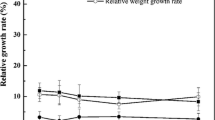Abstract
The ever-increasing environmental pollution necessitates organisms to develop specific defense systems in order to survive and function effectively. Lead is taken up by plants mainly through roots and over 96% are accumulated there.Pea plants were cultivated hydroponically for 4 days with 0.1, 0.5 and 1 mM Pb(NO3)2. Uptake of lead ions from nutrient solution and accumulation in root stems and leaves during 96-h cultivation was estimated. The root tip cells were observed with transmission electron microscope to analyse their ultrastructure and lead localization. Pb was accumulated in the cell wall, cell membrane, vacuoles, mitochondria and peroxisomes. The fractions of mitochondria and peroxisomes were isolated from pea roots purified by means Percoll gradient, and were observed by means of electron microscope with the attachment for X-ray microanalysis. Visible deposits containing Pb were observed in both cell organelles.






Similar content being viewed by others
References
Antosiewicz D (2005) Study of calcium-dependent lead-tolerance on plants differing in their level of Ca-deficiency tolerance. Environ Pollut 134:23–34
Antosiewicz D, Wierzbicka MM (1999) Localization of lead in Alium cepa L. cells by electron microscopy. J Microsc 195:139–146
Baralkiewicz D, Kozka M, Gramowska H, Tomaszewska B, Wasinkiewicz K (2004) Determination of lead in plants in controlling phytoremediation processes using slurry sampling electrothermal atomic absorption spectrometry. Int J Environ Anal Chem 84:901–908
Chen XC, Wang YP, Lin Q, Shi JY, Wu WX, Chen YX (2005) Biosorption of copper (II) and zinc (II) from aqueous solution by Pseudomonas putia CZ1. Colloids Surf B 46:101–107
Colangelo EP, Gueriont ML (2006) Put the metal to the petal: metal uptake and transport throughout plants. Curr Opin Plant Biol 9(3):322–330
Eboh L, Mepba HD, Ekpo MB (2006) Heavy metal contaminants and processing effects on the composition, storage stability and fatty acid profiles of five common commercially available fish species in Oron Local Government, Nigeria. Food Chem 97:490–497
Hall JL (2001) Cellular mechanisms for heavy metal detoxification and tolerance. J Exp Bot 53:1–11
Jarvis MD, Leung DWM (2001) Chelated lead transport in Chamaecytisus proliferus (L.f.) link ssp. proliferus var. palmensis (H. Christ): an ultrastructural study. Plant Sci 161:433–441
Jian-Yi S, Ming-Yan J, Jian-Feng W, Nai-Tao Z, Liang-Jian F, Ming-Qi L, Lin P (2006) Effect of zinc of biochemical parameters and changes in related gene expression assessed by cDNA microarrays in pituitary of growing rats. Nutrion 22:187–196
Leopold I, Günther D (1997) Investigation of binding properties of heavy-metal-peptide complexes in plant cell cultures using HPLC-ICP-MS. J Anal Chem 359:364–370
Liu D, Jiang W, Liu C, Xin C, Hou W (2000) Uptake and accumulation of lead by roots, hypocotyls and shoots of Indian mustard [Brassica juncea (L.)]. Bioresour Technol 71:273–277
Marmiroli M, Antonioli G, Maestri E, Marmiroli N (2005) Evidence of the involvement of plant ligno-cellulosic structure in the sequestration of Pb: an X-ray spectroscopy-based analysis. Environ Pollut 134:217–227
Perez de Mora A, Burgos P, Madejon E, Cabrera F, Jaeckel P, Schloter M (2006) Microbial community structure and function in a soil contaminated by heavy metals: effects of plant growth and different amendments. Soil Biol Biochem 38:327–341
Piechalak A, Tomaszewska B, Baralkiewicz D (2003) Enhancing phytoremediative ability of Pisum sativum by EDTA application. Phytochemistry 62:1239–1251
Piechalak A, Tomaszewska B, Baralkiewicz D, Malecka A (2002) Accumulation and detoxification of lead ions in legumes. Phytochemistry 60:153–167
Polec-Pawlak K, Ruzik R, Lipec E, Ciurzynska M, Gawronska H. (2007) Investigation of Pb(II) binding to pectin in Arabidopsis thaliana. J Anal Atom Spectrom 22:968–972
Robinson DG, Hillmer S (1990) Endocytosis in plants. Physiol Plant 79:96–104
Samardakiewicz S, Wozny A (2000) The distribution of lead in duckweed (Lemna mimor L.) root tip. Plant Soil 226:107–111
Schűtzendűbel A, Polle A (2002). Plant responses to abiotic stresses: heavy metal- induced oxidative stress and protection by mycorrhization. J Exp Bot 53:1351–1365
Seregin IV, Pekhov VM, Ivanow VB (2002) Plasmolysis as a tool to reveal lead localization in the apoplast of root cells. Russ J Plant Physiol 49:283–285
Singh RP, Tripathi RD, Sinha SK, Maheshwari R, Srivastava HS (1997) Response of higher plants to lead contaminated environment. Chemosphere 34:2467–2493
Tung G, Temple PJ (1996) Uptake and localization of lead in corn (Zea mays L.) seedlings, a study by histochemical and electron microscopy. Sci Total Environ 188:71–85
Wierzbicka M (1987) Lead accumulation and its translocation barriers in roots of Allium cepa L.—autoradiographic and ultrastructural studies. Plant Cell Environ 10:17–26
Wierzbicka M (1995) How lead loses its toxicity to plants. Acta Soc Bot Pol 64:81–90
Wierzbicka M (1999) Comparison of lead tolerance in Allium cepa with other plant species. Environ Pollut 104:41–52
Wojcik M, Tukiendorf A (2003) Response of wild type of Arabidopsis thaliana to copper stress. Biol Plant 46:79–84
Wozny A, Krzeslowska M, Tomaszewska B, Wozny A (1995) In: Wozny A (ed) Lead in plant cells. Sorus, Poznan, pp 21–110 (in polish)
Zenk MH (1996) Heavy metal detoxification in higher plants—a review. Gene 179:21–30
Acknowledgments
This work was supported by the State Committee for Scientific Research (KBN), grant no. 2 P04G 069 26.
Author information
Authors and Affiliations
Corresponding author
Additional information
Communicated by A. Tukiendorf.
Rights and permissions
About this article
Cite this article
Małecka, A., Piechalak, A., Morkunas, I. et al. Accumulation of lead in root cells of Pisum sativum . Acta Physiol Plant 30, 629–637 (2008). https://doi.org/10.1007/s11738-008-0159-1
Received:
Revised:
Accepted:
Published:
Issue Date:
DOI: https://doi.org/10.1007/s11738-008-0159-1




